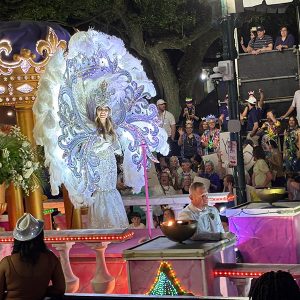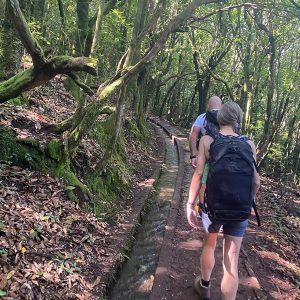Silver Travellers will hopefully remember the James Bond movie For Your Eyes Only, the 1981 vintage with Roger Moore as 007 and Carole Bouquet as that year’s shaken and stirred Bond girl, Melina Havelock.
One of the film’s most memorable locations is the Holy Trinity Monastery. It clings to a rocky outcrop, over 400 metres high and was built between the 14th and 15th centuries.
The monastery is one of 24 originally built in Meteora, now a remarkable UNESCO World Heritage site, close to the town of Kalambaka and just over 200 kilometres south-west of Thessaloniki, in northern Greece.
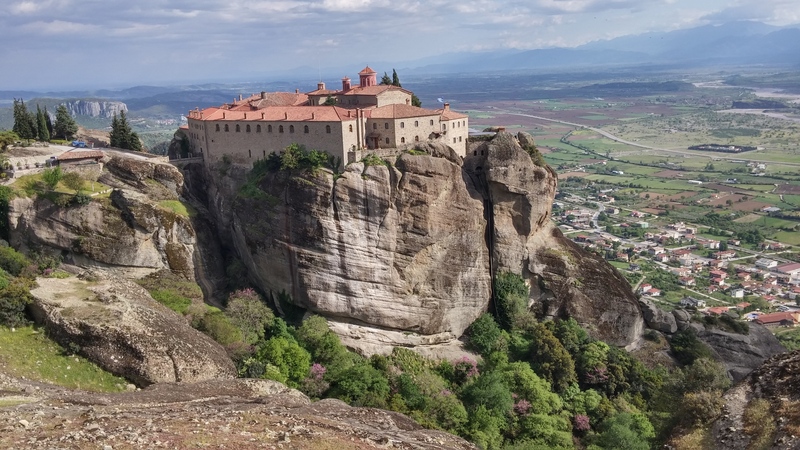
Why is it so special?
Because of its geography and geology: situated in the Peneas Valley in Thessaly, the Meteora monasteries are built on 60 million year-old rocks. Consisting largely of sandstone, cones sprang up towards the sky during earthquakes, forming steep rock columns from an otherwise flat landscape. Like pimples exploding on a teenager’s otherwise unblemished face.
Because of its history: inhabited by hermit monks as early as the 9th century, Meteora’s first – and largest – formal monastery was the Great Meteoron, built between 1356 and 1372 by followers of a priest relocating from Mount Athos. Later, towards the end of the 14th century as marauding Turks brought to an end the Byzantine Empire’s 800-year reign over northern Greece, hermit monks found the rocks of Meteora to be an ideal sanctuary. More than 20 monasteries were built originally, with only 6 remaining today.
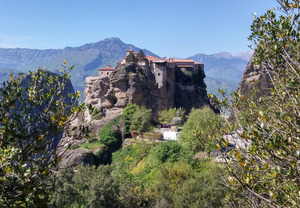 Because of its religious importance: hundreds of Greek Orthodox monks lived and worshipped here for centuries, making it a very holy location, then and now. Today, only a few monks inhabit each remaining monastery, the improved accessibility to tourists understandably not sitting easily with the concept of solitude and quiet prayer.
Because of its religious importance: hundreds of Greek Orthodox monks lived and worshipped here for centuries, making it a very holy location, then and now. Today, only a few monks inhabit each remaining monastery, the improved accessibility to tourists understandably not sitting easily with the concept of solitude and quiet prayer.
Because of the logistics: looking at the monasteries now, perched so high on top of inaccessible needles of sheer rock, it’s hard to conceive how the monks managed to construct such isolated places of worship without modern building equipment. And some of the pulley systems and nets, used to haul up goods and people to the completed monasteries before later improved access, can be seen in situ. Superlatives are inadequate.
The remaining six monasteries can be visited today, although each closes for at least one day a week, so check before you go. You will have limited access, understandably, but you can get a good feel for the religious sanctity – some of the churches and chapels are open – and certainly understand how inaccessible they would have been. The views alone are worth the very small entrance fees.
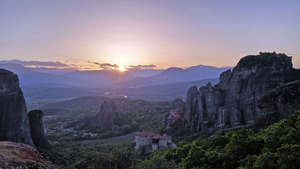 We took a 4 hour afternoon tour with the excellent local Meteora Thrones company. Transported in their VIP luxury minibus, our small multinational group was given access to two monasteries, drove close to the other four, learned all there is to know about Meteora from expert guide Dimitris, and then watched the Greek sun set over the distant horizon, as we all perched on a holy rock.
We took a 4 hour afternoon tour with the excellent local Meteora Thrones company. Transported in their VIP luxury minibus, our small multinational group was given access to two monasteries, drove close to the other four, learned all there is to know about Meteora from expert guide Dimitris, and then watched the Greek sun set over the distant horizon, as we all perched on a holy rock.
A cautionary word for Silver Travellers: if you want to access the monasteries, some of them require a little bit of climbing up and down steep stone steps and walkways. Not as scary as being winched up a few hundred metres in a flimsy net, but still requiring some decent mobility.
The following day, in perfect spring weather, we joined Meteora Thrones walking guide Christos. Starting from Kastraki in the morning and Kalambaka in the afternoon – down towards the plains – we hiked up some of the ancient footpaths, used by the monks for centuries. Christos – call me Chris – told us the names of the beautiful mountain flowers we stumbled across, identified the birdsong, introduced us to wild tortoises – and a snake – and led us up through verdant valleys to the towering rock cones.
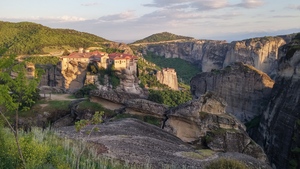 Arriving at the monasteries on foot was perhaps a more rewarding experience than in a Mercedes van, and walking even higher – so that we could look down on the wonders of Meteora, embedded in these soaring sandstone needles – added yet another dimension to our pilgrimage.
Arriving at the monasteries on foot was perhaps a more rewarding experience than in a Mercedes van, and walking even higher – so that we could look down on the wonders of Meteora, embedded in these soaring sandstone needles – added yet another dimension to our pilgrimage.
Back at Kalambaka, outside a bar in the town centre, we celebrated our day with Christos, over a tsipouro. A strong pomace brandy spirit, this is the local beverage with which to share Greek hospitality and friendship. It’s always accompanied by free tapas-style food – mezedes – to share. So we had some more tsipouros, more food, discussed the merits of enjoying the spirit with anise or without, on or off the rocks, stared up at the magical Meteora in the evening sun and slept very well.
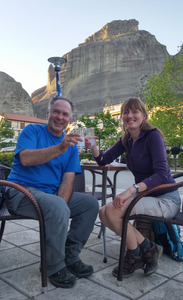 Kalambaka is a functional local town without pretension, other than to host the many visitors to its famous nearby rocks and monasteries. There are many places to stay, eat and drink in if you’re heading this way. We can recommend two traditional restaurants in the heart of the town, the Taverna Panellinio and the Archontariki, both serving fresh, honest Greek food. Try the roast lamb with potatoes and fried zucchini at Panellinio, or the chicken souvlaki with tzatziki at Archontariki. With excellent local Greek wines, or beers (Fix and Mythos hit the spot) or more tsipouro!
Kalambaka is a functional local town without pretension, other than to host the many visitors to its famous nearby rocks and monasteries. There are many places to stay, eat and drink in if you’re heading this way. We can recommend two traditional restaurants in the heart of the town, the Taverna Panellinio and the Archontariki, both serving fresh, honest Greek food. Try the roast lamb with potatoes and fried zucchini at Panellinio, or the chicken souvlaki with tzatziki at Archontariki. With excellent local Greek wines, or beers (Fix and Mythos hit the spot) or more tsipouro!
We stayed at the Hotel Famissi on the main street in Kalambaka. It’s a 3* superior hotel, with a grand lobby and dining room, but lacking in atmosphere – and service – a little when we were there. But the view from our balcony, across a few roof-tops to the holy rocks and monasteries, was unforgettable. Their sister hotel, the Famissi Eden, is a 4* resort hotel and a short way from the main street, but rooms at the back have uninterrupted views to Meteora.
If you’re staying in Thessaloniki for more than a few days, the trip south to see Meteora is an unforgettable addition. The bus service – get off at Trikala and transfer to Kalambaka – is clean, quick and cheap. Or hire an Aston Martin and pretend you’re James Bond, to return to the Holy Trinity Monastery even quicker.


